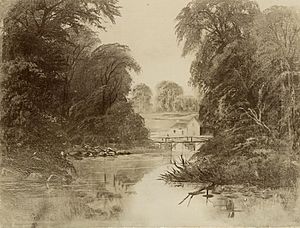Todmorden Mills facts for kids
Todmorden Mills was once a small village in the Don River valley in Toronto, Ontario. It began as a lumber mill in the 1790s. The area was first called "Don Mills." Over time, it grew into a busy place with factories and homes. Later, in the 1900s, it became part of East York. Today, the site is home to the Todmorden Mills Heritage Museum and Arts Centre. This special place has a museum, an art gallery, a theatre, and a beautiful forest preserve.
History
Early Beginnings
In 1795, the town of York (now Toronto) was growing. To help build the town, Lieutenant-Governor John Graves Simcoe gave land on the Don River to Aaron and Isaiah Skinner. They were to build a mill to cut lumber. A third partner was Parsall Terry. He was the first person to manage the water flow on the Don River.
The Skinner family ran the mill until about 1855. Then, the Taylor family bought it. In 1820, a brewery was built next to the mill. It was run by Thomas Helliwell and John Eastwood. The Helliwell family operated the brewery until 1855. They also sold it to the Taylor family.
Todmorden Mills got its name from John Eastwood. His family came from a town called Todmorden in England.
Growing Up
The Taylor family owned many mills nearby. This included the Don Valley Brick Works. Under their ownership, the mill at Todmorden Mills changed. It started making felt paper instead of lumber. The paper mill kept working until the 1920s. After that, the building became a place for horse riding.
In the early 1940s, during World War II, the site had a small camp. It held German prisoners of war. These were sailors from German merchant ships. They had been held in Allied ports when the war began. The prisoners often worked at the nearby Don Valley Brick Works. In 1945, the war ended, and the prisoners went home. The camp was then closed. Soon after, the camp buildings were destroyed by fire.
Between 1930 and 1967, the property was used for different things. It housed several horse riding schools. These included the Windermere Riding Academy and the Whitewood Riding School. There were also some small businesses.
During the building of the Don Valley Parkway, the area changed a lot. The Don River used to curve through the site. Now, it was straightened. This cut off the river from the old mill site. The old riverbed became a pond. A bridge that once crossed the river now only leads to a parking lot.
Later Years and the Museum
In 1965, the mayor of East York, True Davidson, suggested a special project. She wanted to turn the mill site into a museum for Canada's 100th birthday. On May 22, 1967, it opened as the Todmorden Mills Historic Site. It became a community museum. Mayor Davidson helped manage it until she passed away in 1978.
Today, the museum has four historic buildings. These include the old paper mill from 1825. There is also the brewery and two old homes. The Don railway station was moved to Todmorden in 1969. It stayed there until 2009. Then, it moved to Roundhouse Park. The museum hopes to restore the Helliwell House. They want it to look like it did in the 1890s.
In 1991, two nature lovers, Charles Sauriol and Dave Money, had an idea. They wanted to turn a small forest next to the museum into a nature preserve. A group was formed, and the Todmorden Mills Wildflower Preserve was created. Since then, the group has worked to restore the forest. They remove plants that don't belong there. They also plant flowers and trees native to the Toronto area.
See also
- John Taylor (paper manufacturer)
- Pape Village




